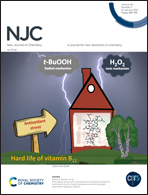An efficient environmentally friendly CuFe2O4/SiO2 catalyst for vanillyl mandelic acid oxidation in water under atmospheric pressure and a mechanism study†
Abstract
With the aim of the green production of vanillin, a highly efficient environmentally friendly oxidation system was introduced to oxidize vanillyl mandelic acid (VMA) with a porous CuFe2O4/SiO2 component nano-catalyst in aqueous solution under atmospheric pressure. The N2 adsorption–desorption pattern indicated that CuFe2O4/SiO2 possessed a much higher specific surface area (49.98 m2 g−1) than that of CuFe2O4 (5.02 m2 g−1), which further indicated that the SiO2 substrate restrained the aggregation of CuFe2O4 nanoparticles. The conversion for VMA and selectivity for vanillin reached 98% and 96%, respectively, under atmospheric pressure. The excellent catalytic performance was attributed to the synergistic effect of the catalytic capacity of CuFe2O4 and the adsorption capacity for the reactant of SiO2. Simultaneously, the effect of different reaction conditions for catalyst activity and selectivity were investigated. Furthermore, the probable mechanism of VMA oxidation was investigated by in situ ATR-FTIR, H2-TPR, XPS and 1H NMR. More importantly, the decarboxylation was verified to proceed in basic conditions rather than in conventional acidic conditions.



 Please wait while we load your content...
Please wait while we load your content...